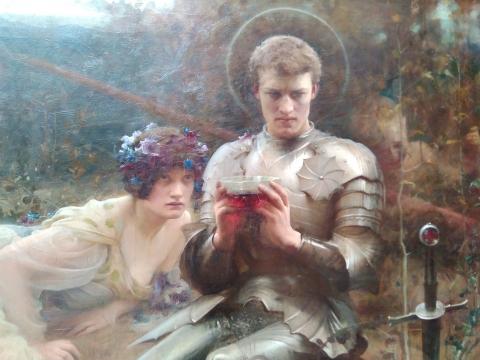The Temptation of Sir Percival (1894)

Arthur Hacker’s The Temptation of Sir Percival of 1894 shows Percival, one of King Arthur's legendary Knights of the Round Table, being tempted with things of the flesh. These are personified by a beautiful, but predatory woman. She gives him food and wine, but she is Satan in disguise, hoping to keep him from attaining the Holy Grail. She flatters and confuses him until Sir Percival sees his danger and takes his leave.
The tale is based upon an ancient British legend, much embellished and embroidered with time’s passing. Percival first appears in Chrétien de Troyes’s unfinished Percivale or Conte del Graal (c.1190) and has been much developed therafter. In real life, each one of us is tempted by evil; each one has several weaknesses by which we may be lured to our destruction. The picture cleverly shows the tempter’s intensive desire that the noble knight falls, as well as showing his resolution to remain true and faithful. In 1 Thessalonians 3:4-6, the apostle Paul writes:
For, in fact, we told you before when we were with you that we would suffer tribulation, just as it happened, and you know. For this reason, when I could no longer endure it, I sent to know your faith, lest by some means the tempter had tempted you, and our labour might be in vain. (New King James Version).
Paul seems to be intimating that temptation itself would be responsible for their fall. Yet elsewhere, Apostle John writes
You are of God, little children, and have overcome them, because He who is in you is greater than he who is in the world. 1 John 4:4, NKJV
The Tempter might be wily, his temptations might fascinate and our spirits might be feeble, but the Comforter- the mighty Spirit of Jehovah who hovered over the primeval waters ahead of creation, lives within us. He generously shares His strength and power, enabling us to say ‘NO’ to ungodliness.
- Log in to post comments


 Sunday Worship 10.45am & 6.00pm
Sunday Worship 10.45am & 6.00pm